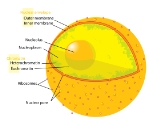
Nucleolus
Overview
The nucleolus is a non-membrane bound structure composed of proteins and nucleic acids found within the nucleus
. Ribosomal RNA
(rRNA) is transcribed
and assembled within the nucleolus. The nucleolus ultrastructure can be visualized through an electron microscope
, while the organization and dynamics can be studied through fluorescent protein tagging
and fluorescent recovery after photobleaching
(FRAP
). Malfunction of nucleoli can be the cause for several human diseases.
Cell nucleus
In cell biology, the nucleus is a membrane-enclosed organelle found in eukaryotic cells. It contains most of the cell's genetic material, organized as multiple long linear DNA molecules in complex with a large variety of proteins, such as histones, to form chromosomes. The genes within these...
. Ribosomal RNA
Ribosomal RNA
Ribosomal ribonucleic acid is the RNA component of the ribosome, the enzyme that is the site of protein synthesis in all living cells. Ribosomal RNA provides a mechanism for decoding mRNA into amino acids and interacts with tRNAs during translation by providing peptidyl transferase activity...
(rRNA) is transcribed
Transcription (genetics)
Transcription is the process of creating a complementary RNA copy of a sequence of DNA. Both RNA and DNA are nucleic acids, which use base pairs of nucleotides as a complementary language that can be converted back and forth from DNA to RNA by the action of the correct enzymes...
and assembled within the nucleolus. The nucleolus ultrastructure can be visualized through an electron microscope
Electron microscope
An electron microscope is a type of microscope that uses a beam of electrons to illuminate the specimen and produce a magnified image. Electron microscopes have a greater resolving power than a light-powered optical microscope, because electrons have wavelengths about 100,000 times shorter than...
, while the organization and dynamics can be studied through fluorescent protein tagging
Fluorophore
A fluorophore, in analogy to a chromophore, is a component of a molecule which causes a molecule to be fluorescent. It is a functional group in a molecule which will absorb energy of a specific wavelength and re-emit energy at a different wavelength...
and fluorescent recovery after photobleaching
Photobleaching
Photobleaching is the photochemical destruction of a fluorophore. In microscopy, photobleaching may complicate the observation of fluorescent molecules, since they will eventually be destroyed by the light exposure necessary to stimulate them into fluorescing...
(FRAP
Fluorescence recovery after photobleaching
Fluorescence recovery after photobleaching denotes an optical technique capable of quantifying the two dimensional lateral diffusion of a molecularly thin film containing fluorescently labeled probes, or to examine single cells. This technique is very useful in biological studies of cell membrane...
). Malfunction of nucleoli can be the cause for several human diseases.
Unanswered Questions
Discussions

